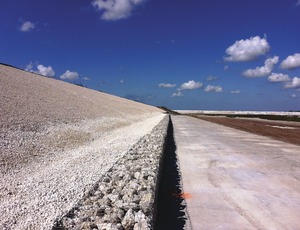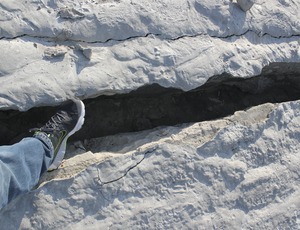

Two years after a federal jury denied Tampa Bay Water (TBW) damages for cracks at its then-six-year-old, Lithia, Fla., reservoir, the regional water supplier is eyeing better days as a $129-million renovation nears completion.
While Kiewit Infrastructure Group is targeting a November completion, the Florida Dept. of Environmental Protection (FDEP) may allow TBW to begin refilling the 15.5-billion-gallon C.W. "Bill" Young Regional Reservoir sometime in August.
"The agency hopes to fill the facility half of the way while the contractor finishes work on the top of the reservoir," utility spokeswoman Michelle Biddle Rapp told ENR via email.
The redo centers on rebuilding the reservoir's embankment, where the cracking had occurred. This time around, engineer Gannett Fleming is using a stair-step soil-cement system, which measures up to 33 in. thick, over an aggregate layer. Trent Dreese, project manager, calls the design "significantly more conservative" than the original embankment, which featured 16 in. of flat-plate soil-cement atop a soil wedge.
The fix is a "strong technical solution" that the utility expects to "deliver long-term reliability," said Jon Kennedy, TBW's engineering support manager, in a statement.
For the renovation, Kiewit hired soil-cement consultant Ken Hansen to advise on the design's durability and appearance. Hansen, an independent consultant, was involved in the early-1960s construction of New Mexico's Ute Dam, the first U.S. dam to use soil-cement.
The result of the redo should be "a very good-performing soil-cement," says Hansen. "It has sufficient strength and durability, and it will perform extremely well."
The new embankment's stair-step system, featuring layers bonded together with a cement slurry, "will enhance the performance greatly," he adds. The new design incorporates a continuous outlet.
TBW is looking forward to reactivating the reservoir, which has been empty since before February 2013, when construction started.
"The regional reservoir is an integral part of the region's drinking-water supply system," Rapp said via email. "Having that facility back on line provides the essential storage we need to provide drinking water during the dry times of the year when river flows are low."
Earlier, the utility had hoped to add an extra 3 billion gallons of capacity to its supply system by expanding the reservoir to 18.5 billion gallons. But during the renovation's permitting stage, data and analysis from the FDEP suggested that an expansion could overload the area geography's capacity to resist sinkhole development. In April 2012, the state agency noted that if one existing sinkhole reactivated, it had the potential "to undermine the reservoir embankment." Shortly after, former TBW General Manager Gerald Seeber scuttled the estimated $41-million expansion.


Post a comment to this article
Report Abusive Comment